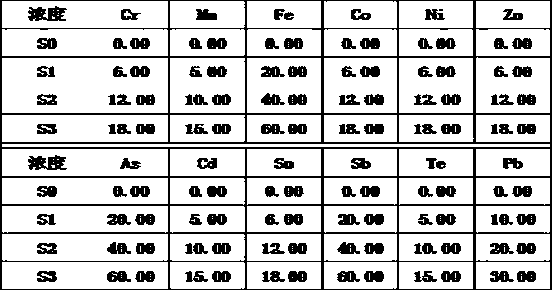Method for quickly separating copper matrix for ICP-MS analysis of impurity elements in metal copper
A technology of ICP-MS and impurity elements, which is applied to the analysis of materials, the preparation of test samples, and the analysis of materials by electromagnetic means. Analysis, no matrix interference, and the effect of reducing the amount of use
- Summary
- Abstract
- Description
- Claims
- Application Information
AI Technical Summary
Problems solved by technology
Method used
Image
Examples
Embodiment
[0025] 1) Take 20mL of mixed acid in a 200mL volumetric flask, dilute to volume with water, and shake well. as a blank solution.
[0026] 2) Accurately weigh 2.00g of sample as the sample to be analyzed.
[0027] 3) Put the sample to be tested into a 150mL tall beaker, add 20mL mixed acid solution and heat until completely dissolved, add 100mL ultrapure water, and stir well. Install the platinum cathode and platinum anode on the electrolyzer properly and put them into the solution, and cover the tall beaker with two and a half watch glasses. Perform electrolysis at a current density of about 3-3.5A / dm2 on the surface of the cathode until the solution is colorless (about 1-2h). Without cutting off the current, remove the two and a half watch glasses, pull out the platinum electrode, and Wash off with water. Transfer the solution in the beaker to a 200mL volumetric flask, make up to volume with ultrapure water, and prepare the solution to be tested.
[0028] 4) Standard solu...
PUM
| Property | Measurement | Unit |
|---|---|---|
| diameter | aaaaa | aaaaa |
Abstract
Description
Claims
Application Information
 Login to View More
Login to View More - R&D
- Intellectual Property
- Life Sciences
- Materials
- Tech Scout
- Unparalleled Data Quality
- Higher Quality Content
- 60% Fewer Hallucinations
Browse by: Latest US Patents, China's latest patents, Technical Efficacy Thesaurus, Application Domain, Technology Topic, Popular Technical Reports.
© 2025 PatSnap. All rights reserved.Legal|Privacy policy|Modern Slavery Act Transparency Statement|Sitemap|About US| Contact US: help@patsnap.com


